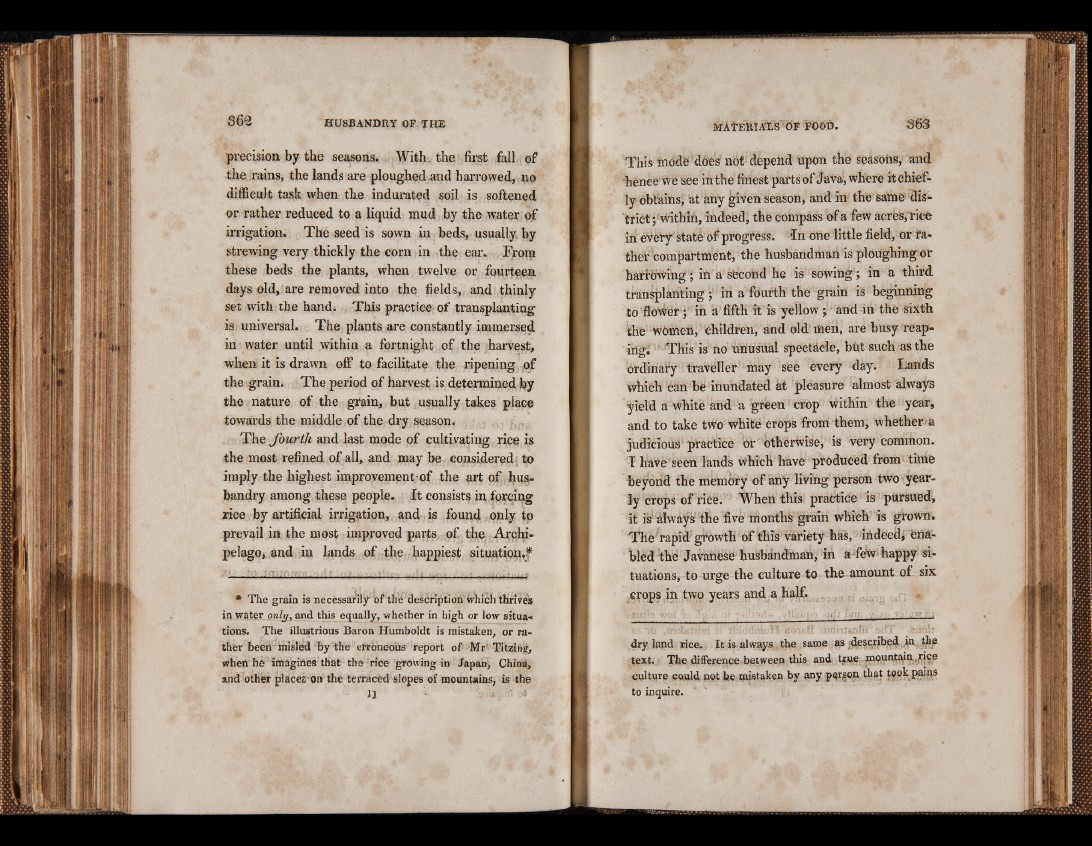
precision by the seasons. With, the first fall of
the rains, the lands are ploughed.and harrowed, ro
difficult task when the indurated soil is softened
or rather reduced to a liquid mud by the water of
irrigation. The seed is sown in beds, usually by
strewing very thickly the corn in the ear. From
these beds the plants, when twelve or fourteen
days old, are removed into the fields, and thinly
set with the hands This practice of transplanting
is universal. The plants are constantly immersed
in water until within a fortnight of the harvest,
when it is drawn off to facilitate the ripening of
the grain* The period of harvest is determined by
the nature of the grain, but usually takes place
towards the middle of the dry season*
Thq fou rth and last mode of cultivating rice is
the most refined of all, and may be considered to
imply the highest improvement of the art of husbandry
among these people. It consists in forcing
rice by artificial irrigation, and is found only to
prevail in the most improved parts of the Archipelago,
and in lands of the happiest situation,^
* The grain is necèssatiiÿ bf thé description which thrives
in water only, and this equally, whether in high or low situa*
tions. The illustrious Baron Humboldt is mistaken, or rather
been" misted by the erroneous report of Mr' Titzing,
when hé imagines that the rice growing in Japan, China,
and other places on the terraced slopes of mountains, is the
,u • % al, 1.4
This mode does not depend upon the seasons, and
hence we see in the finest parts of Java, where it chiefly
obtains, at any given season, and in the same district;
within, indeed, the compass of a few acres, rice
in every state of progress. *In one little field, or father
compartment, the husbandman is ploughing or
harròrting ; in a sCcoiid he is sowing ; in a third
transplanting ; in a fourth the grain is beginning
to flower ; in a fifth it is yellow and in the sixth
the women, children, and old men, are busy reap-
iiigi This is no unusual spectacle, but such as the
ordinary traveller may see every day. Lands
which can be inundated at pleasure almost always
yield à white and a green cirop within the year,
and to take tvVo white crops from them, whether a
judicious practice or otherwise, is very common.
I have seen lands which have produced from time
beyond the memory of any living person two yearly
crops of rice. When this practice is pursued,
it is always the five months grain which is grown.
The'rapid growth of this variety has, indeed, enabled
the Javaiifesd husbandman, in a few happy situations,
to urge the culture to the-amount of six
crops in two years and a half. ..
dry land rice. I t is always the same as .described in.
text. The difference between this and tjue mpuntain,,rice
culture could not be mistaken by any pergon that took pains
to inquire. '